#the montessori academy of arlington
Text

Early Childhood - Nomenclature Cards: Human Anatomy
Montessori Nomenclature cards are used for classifying and building vocabulary and concepts in all subject areas. Also known as 3-part cards, this material is made up of a control card, which has the picture and word on the same card, and individual pictures and labels. Students then match the individual pictures and labels to the correct control card, providing for in-depth visual discrimination practice and independence, as students do not need to ask the teacher for help to check their work. For this 4-year-old student, the teachers have extended the work to include realistic objects and word tracing, adding layers of complexity to the work.
#human anatomy#3-part cards#hands on learning#language#purposeful activity#always learning#order#concentration#coordination#independence#tma#montessori#private school#arlingtontx#arlington#texas#infant#nido#toddler#early childhood#preschool#kindergarten#elementary#education#private education#nontraditional#the montessori academy of arlington
4 notes
·
View notes
Note
(I’m the stranger preschool anon, lol) it’s called The Montessori Academy of Arlington, it has a tumblr for some reason, and uses the acronym TMA so every once in a while I’ll be scrolling the tag and suddenly there’s Children. they’re adorable tho
children and the magnus archives DO NOT and SHOULD NOT mix
24 notes
·
View notes
Photo
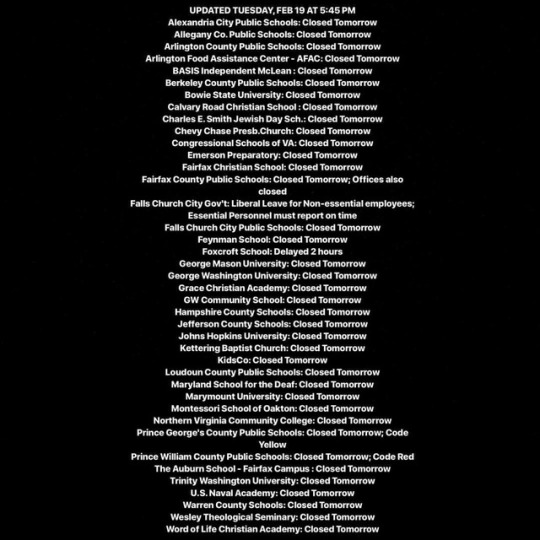
#CourtesyOf Tomorrow CLOSINGS... UPDATED TUESDAY, FEB 19 AT 5:45 PM Alexandria City Public Schools: Closed Tomorrow Allegany Co. Public Schools: Closed Tomorrow Arlington County Public Schools: Closed Tomorrow Arlington Food Assistance Center - AFAC: Closed Tomorrow BASIS Independent McLean : Closed Tomorrow Berkeley County Public Schools: Closed Tomorrow Bowie State University: Closed Tomorrow Calvary Road Christian School : Closed Tomorrow Charles E. Smith Jewish Day Sch.: Closed Tomorrow Chevy Chase Presb.Church: Closed Tomorrow Congressional Schools of VA: Closed Tomorrow Emerson Preparatory: Closed Tomorrow Fairfax Christian School: Closed Tomorrow Fairfax County Public Schools: Closed Tomorrow; Offices also closed Falls Church City Gov't: Liberal Leave for Non-essential employees; Essential Personnel must report on time Falls Church City Public Schools: Closed Tomorrow Feynman School: Closed Tomorrow Foxcroft School: Delayed 2 hours George Mason University: Closed Tomorrow George Washington University: Closed Tomorrow Grace Christian Academy: Closed Tomorrow GW Community School: Closed Tomorrow Hampshire County Schools: Closed Tomorrow Jefferson County Schools: Closed Tomorrow Johns Hopkins University: Closed Tomorrow Kettering Baptist Church: Closed Tomorrow KidsCo: Closed Tomorrow Loudoun County Public Schools: Closed Tomorrow Maryland School for the Deaf: Closed Tomorrow Marymount University: Closed Tomorrow Montessori School of Oakton: Closed Tomorrow Northern Virginia Community College: Closed Tomorrow Prince George's County Public Schools: Closed Tomorrow; Code Yellow Prince William County Public Schools: Closed Tomorrow; Code Red The Auburn School - Fairfax Campus : Closed Tomorrow Trinity Washington University: Closed Tomorrow U.S. Naval Academy: Closed Tomorrow Warren County Schools: Closed Tomorrow Wesley Theological Seminary: Closed Tomorrow Word of Life Christian Academy: Closed Tomorrow https://www.instagram.com/p/BuFLIyPgFvK/?utm_source=ig_tumblr_share&igshid=1hfgslduyyp55
0 notes
Link
We are a licensed child care facility offering lessons curated by our director who has 10+ years of teaching experience, as well as a Master’s. Integrating Montessori teaching strategies paired with critical thinking, creativity, and structured exploratory learning activities. As educators we understand the importance of of communication and make sure to communicate with our parents in real time, with our integrated smart phone application.
Please contact us for further information at our number or our email.
(817)-583-6321
0 notes
Text
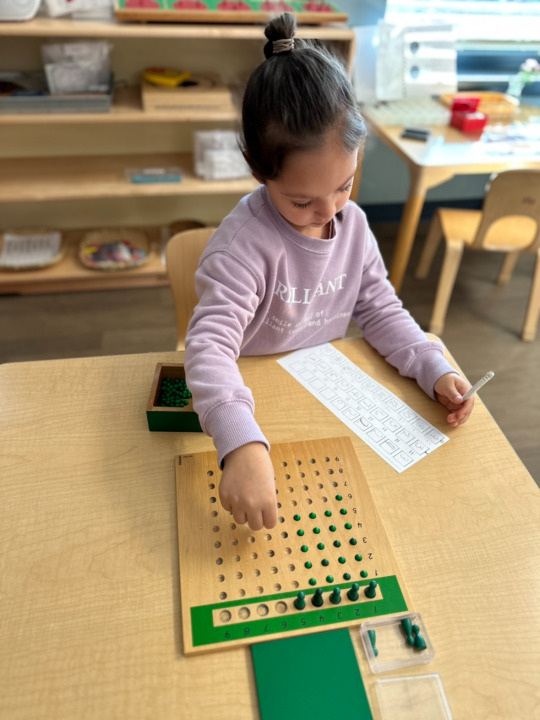
Early Childhood Kindergarten - Division Bead Board
Division while in Kindergarten?? With the Montessori approach, math can be fun while also challenging! The Montessori division board introduces children to the concept of division by allowing them to explore it in a concrete way, as they learn to "share" the beads equally between the skittles at the top of the board. They will be able to check their own work by making sure there are no leftover beads without relying on an adult. Once they have mastered division problems with no remainder, they can move on to equations that will have a remainder and will be able to self-correct if they notice the remainder is larger than the dividend. Dr. Maria Montessori believed that children absorb and retain information for prolonged periods when they learn through hands-on activities with concrete materials. Young children appreciate the repetitive nature of the materials, which gives them plenty of opportunities to practice and internalize the concept before moving on to dividing numbers abstractly.
#concrete to abstract#math is fun#division#hands on learning#experiential learning#order#concentration#coordination#independence#focus#tma#montessori#private school#arlingtontx#arlington#texas#infant#nido#toddler#early childhood#preschool#kindergarten#elementary#education#private education#nontraditional#the montessori academy of arlington
0 notes
Text
Mentorship in the Montessori Classroom
Among the many benefits of a mixed-age classroom is the chance for older students to become mentors to their peers. This not only builds confidence and leadership skills, but reinforces their previous knowledge when they are able to pass it on to others. In the infant and toddler classrooms, this happens naturally as the younger students often enjoy, and even seek out their older peers to observe their work. As they transition to the Early Childhood classroom, they are given the chance to give lessons and quiz each others' knowledge. In one picture, one student is reading puzzle sight words from the stack so that another student can find them solely by sound. In another picture, one older student gives a lesson on tik-tac-toe to some younger peers while on in the outdoor classroom. A sixth grader even had the opportunity to mentor some Early Childhood students while handling their classroom hermit crab. These experiences are incredibly valuable and enrich our school's sense of community and cooperation.
#intrinsic motivation#cognitive stimulation#collaboration#leadership#learn from peers#social skills#independence#mentor#mixed age classroom#tma#montessori#private school#arlingtontx#arlington#texas#infant#nido#toddler#early childhood#preschool#kindergarten#elementary#education#private education#nontraditional#the montessori academy of arlington
0 notes
Text

Upper Elementary - Squares and Square Roots
As the Upper Elementary students approach middle school age, they are introduced to algebraic concepts like square roots, balancing equations, and polynomials. Through the Montessori approach, they can visualize these concepts by manipulating concrete materials that will help them more fully grasp the concepts. This student is very focused, using the Square Root Peg Board to build the square of 27 in single units (green pegs), and then exchanging them with the blue pegs, which represent ten units each. Once she has exchanged it, she will be able to clearly see the root. This material helps students understand more complex math concepts thoroughly before transitioning to working through them more abstractly on pen and paper.
#algegra#arithmatic#math is fun#hands on learning#concrete to abstract#order#concentration#coordination#independence#academically prepared#confident learner#competent learner#tma#montessori#private school#arlingtontx#arlington#texas#infant#nido#toddler#early childhood#preschool#kindergarten#elementary#education#private education#nontraditional#the montessori academy of arlington
1 note
·
View note
Text
Early Childhood - Outdoor Classroom
Springtime brings rain, and rain brings fun! Exploring nature at a young age aligns with children’s natural instincts to be scientists and explorers. The outdoors gives them an opportunity to use things they can physically see, feel, and experience to introduce science in a way that is meaningful to them. Here, the children enjoy the sandbox and barefoot creek after a rainy night by building and balancing on bridges, creating dams, and of course, playing in puddles!
"Let the children be free; encourage them; let them run outside when it is raining; let them remove their shoes when they find a puddle of water; and, when the grass of the meadows is damp with dew, let them run on it and trample it with their bare feet; let them rest peacefully when a tree invites them to sleep beneath it's shade; let them shout and laugh when the sun wakes them in the morning as it wakes every living creature that divides its day between waking and sleeping."
--Maria Montessori
#barefoot creek#contact with nature#beauty of nature#explore the natural world#hands on learing#purposeful activity#independence#creative thinker#tma#montessori#private school#arlingtontx#arlington#texas#infant#nido#toddler#early childhood#preschool#kindergarten#elementary#education#nontraditional#the montessori academy of arlington
0 notes
Text

Early Childhood - Metal Insets
Look at that focus and precision! The Metal Insets are a delightful way for a child to prepare for writing. Children use a colored pencil to carefully trace shapes, which helps to develop the fine motor control needed to write small letters. Creating patterns and designs is a secondary goal, but also increases a child’s ability to manipulate a pencil. Perhaps most importantly, this work has many variations and possibilities, and can capture any child’s interest for an extended period of time.
#fine motor skills#purposeful activity#pre-writing skills#focus#order#concentration#coordination#independence#confident learner#competent learner#academically prepared#intrinsic motivation#tma#montessori#private school#arlingtontx#arlington#texas#infant#nido#toddler#early childhood#preschool#kindergarten#elementary#education#private education#nontraditional#the montessori academy of arlington
0 notes
Text

Early Childhood - Language: Puzzle (Sight) Words
This child is very focused in finding the word she has been told by her teacher. The teacher pronounces one of the puzzle words, and the student looks at the choices in front of her to find the correct word, bringing it back to show the choice. If it is correct, she will be told another word and the process repeats. Once children have mastered this set of words, the next set is introduced. Students must use many skills to be successful, listening closely as the teacher says the word, remembering the word as they are walking back to their workspace, visually reviewing the remaining words, and finally sounding out the word to make the correct choice. This work is essential for young children, so they have a rich internal dictionary at their command. These puzzle words do not follow specific phonetic rules but are necessary for communication and need to be memorized.
#sight words#memorization#reading#hands on learning#always learning#purposeful activity#tma#montessori#private school#arlingtontx#arlington#texas#infant#nido#toddler#early childhood#preschool#kindergarten#elementary#education#private education#nontraditional#the montessori academy of arlington
1 note
·
View note
Text
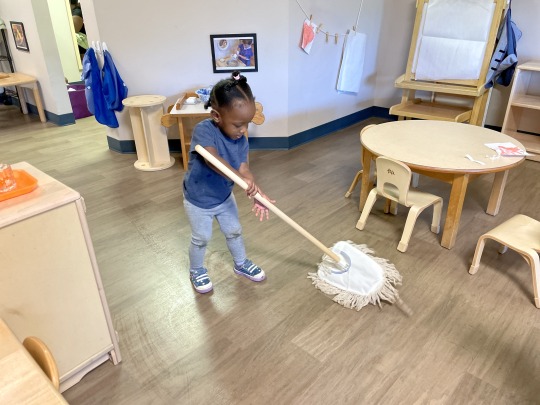

Toddler - Practical Life, Care of Environment
Most ordinary tasks that we do without much thought are new and engaging challenges for our students. The Practical Life curriculum in a Montessori classroom provides a scope and sequence for these everyday routines and practices. By engaging in meaningful activities and using ordinary objects with purposeful ends, the students develop real abilities, which give them independence and control of their lives. The students learn to focus their attention for the entirety of an activity and, upon completion, have a deep sense of fulfilment. Therefore, the aim of these activities is not only practical but also developmental. Through these activities, children develop concentration, independence, coordination of movement, inner discipline, and independence.
#purposeful actiity#hands on learning#experiential learning#practial life#care of environment#order#concentration#cooridnation#independence#routines#tma#montessori#private school#arlingtontx#arlington#texas#infant#nido#toddler#early childhood#preschool#kindergarten#elementary#education#private education#nontraditional#the montessori academy of arlington
0 notes
Text

Early Childhood - Consonant Blends with the Moveable Alphabet
The Moveable Alphabet was developed by Dr. Montessori when she realized that children had the mental capacity to analyze the sounds in words well before they could synthesize them. When children write a word with the Moveable Alphabet, they do so phonetically by analyzing the sounds. After mastering CVC (consonant-vowel-consonant) words, students progress to consonant blends. This student is very focused while using to Moveable Alphabet to make words with the TH blend, both at the beginning and the end of words.
#hands on learning#experiential learning#consonant blends#reading#writing#analyze sounds#order#concentration#coordination#independence#tma#montessori#private school#arlingtontx#arlington#texas#infant#nido#toddler#early childhood#preschool#kindergarten#elementary#education#private education#nontraditional#the montessori academy of arlington
0 notes
Text
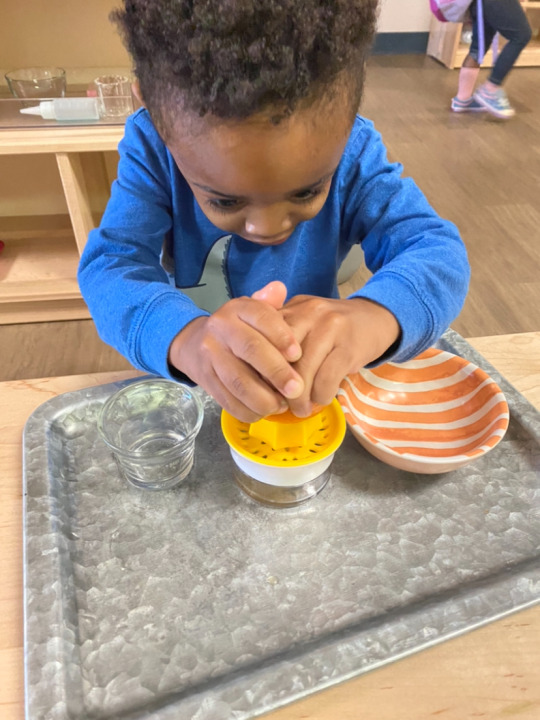

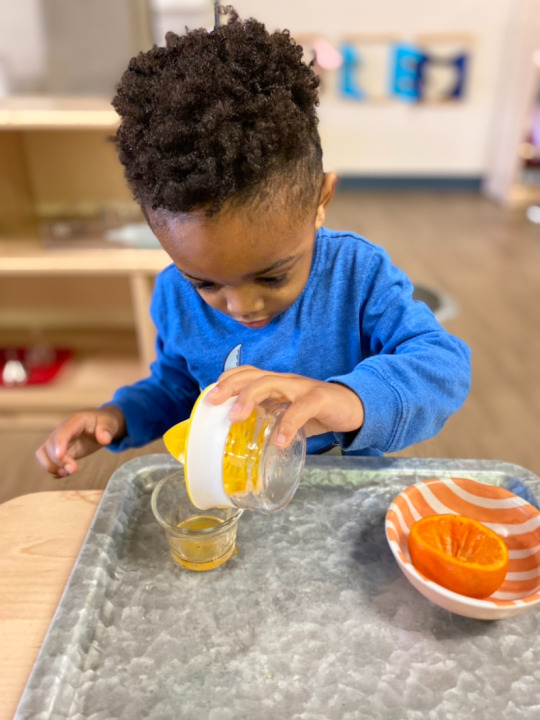
Toddler - Practical Life
This student is very focused while squeezing an orange to make juice for himself. Not only does this work strengthen a child's hand muscles, increase fine motor skills, and develop a child's sense of sequential order, it is purposeful work, allowing the child to literally drink the fruits of their labor.
#focus#purposeful activity#fine motor skills#concentration#coordination#independence#tma#montessori#private school#arlingtontx#arlington#texas#infant#nido#toddler#early childhood#preschool#kindergarten#elementary#education#private education#nontraditional#the montessori academy of arlington
0 notes
Text
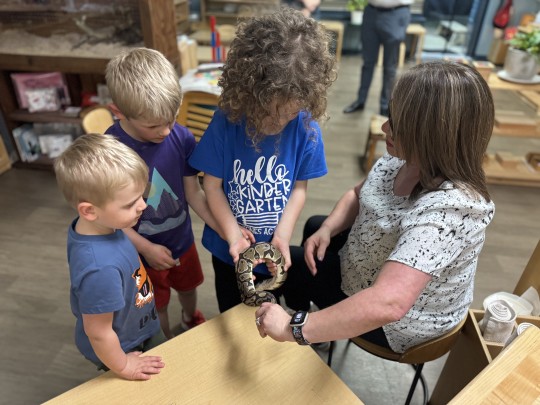
Early Childhood - Caring for Animals
Care of plants and animals is part of the Practical Life curriculum and an important part of Montessori education. Care of pets can be a perfect way for young children to develop a number of skills along with many positive character traits. Including live animals in a child’s daily life greatly enhances their abilities to learn responsibility, empathy, and compassion for other living things, respect for life, and the natural development of living things. The lessons that are instilled in a child through caring for animals will remain with them for the rest of their lives.
#care of environment#care of animals#responsibility#empathy#compassion#social emotional learning#respect for life#always learning#experiential learning#capable#tma#montessori#private school#arlingtontx#arlington#texas#infant#nido#toddler#early childhood#preschool#kindergarten#elementary#education#private education#nontraditional#the montessori academy of arlington
0 notes
Text





Early Childhood - Dressing Frames
The purpose of the dressing frames is to build concentration, coordination, and fine motor control, all the while encouraging children to become more independent as they learn to care for themselves. As children gain more hand-eye coordination and fine motor control, these become easier, and they move on to more challenging frames. Here you can see the variety of the dressing frames, such as buttons, zipper, buckles, belts, and lacing.
#practical life#tenacity#focus#fine motor skills#purposeful activity#hands on learning#experiential learning#order#concentration#coordination#independence#tma#monessori#private school#arlingtontx#alrington#texas#infant#nido#toddler#early childhood#preschool#kindergarten#elementary#education#private education#nontraditional#the montessori academy of arlington
1 note
·
View note
Text




Toddler - Group Mealtime
Young students eat lunch as a community and learn basic table manners as they sit at the tables with placemats, plates, silverware, and cups. They are also given the opportunity to pour their own water once they have been seated at the table. Students have a sense of comradery as they eat together, have conversations, and laugh. Here, a student can even be seen swirling her spaghetti onto her fork. Young children can be capable of so much when given the tools to learn new things and succeed. Once they are finished, they clean up after themselves by putting their used dishes in the appropriate buckets and going to the restroom to wash their hands.
#capable#group meals#social skills#grace and courtesy#manners#social emotional development#concentration#focus#independence#confident learner#competent learner#tma#montessori#private school#arlingtontx#arlington#texas#infant#nido#toddler#early childhood#preschool#kindergarten#elementary#education#private education#nontraditional#the montessori academy of arlington
0 notes